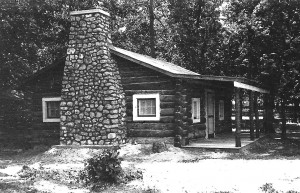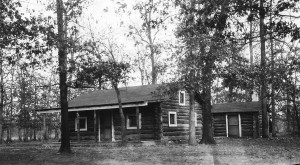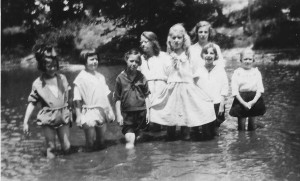In 1921, the Cook County Forest Preserve District built a log cabin in the Bemis Woods for Western Springs’ Girl Scouts. But, where did it go?

Western Springs’ Girl Scout cabin – 1921
In 1920, the first Girl Scout troop in Western Springs was organized. Shortly afterward, an effort was made to have a Girl Scout campsite built in the Bemis Woods, directly north of the village. While the Forest Preserve District of Cook County had turned down eight similar requests from other groups, they agreed to allow a log cabin to be built in the Forest Preserve for the new troop.
According to news reports from that time period, the scouts found a spot in the Bemis Woods near the Salt Creek, a half-mile west of Wolf Road and north of Ogden Avenue, which they felt would be ideal for a campsite. The superintendent of the Cook County Forest Preserve District agreed and, soon, plans were underway for its construction. Best of all, the Forest Preserve District agreed to build the structure at no cost to the Girl Scouts.

View of both log cabin and kitchen
The log cabin, which was to be used by the scouts for overnight campouts, had seven windows, two doors, and a fireplace constructed from stones gathered from the banks of the Salt Creek. The cabin was to be called “High Banks”, a reference to the banks of the nearby Salt Creek.
Newspaper reports described the cabin as being “… an exceedingly artistic structure, with a magnificent chimney and fireplace made of rough fieldstone.” The cabin also had an incinerator built of rough fieldstone for burning refuse, a log kitchen, a water well, and “…other necessary accommodations for both men and women.”
The Forest Preserve District even supplied an additional load of logs to construct a temporary dam near the cabin. This would raise the water level in the Salt Creek by another three or four feet, thereby allowing the Girl Scouts to have better swimming and canoeing in the summer, and ice skating in the winter. The Western Springs American Legion Post offered to construct the dam.

Girl Scouts wading in Salt Creek – circa 1921
On October 15, 1921, the cabin was ready to be dedicated. And, no fewer than five County Board Commissioners were in attendance, no doubt drawn by the promise of a fried chicken dinner served to them at noon in the new cabin.
At 2:15 p.m., a train arrived in Western Springs carrying Girl Scouts from other western suburbs located along the Chicago, Burlington & Quincy Railroad, also known as the “Q”. After disembarking the train, they marched 1½ miles north to the new cabin.
At 3 p.m., an American flag was raised, followed by a bugle call. The president of Western Springs, Henry Reeve, then spoke, welcoming everyone. After dedicating a bronze tablet, eight visiting Girl Scout troops sang a song, “Hail the Cabin,” which was written especially for the occasion:
On the high banks of Salt Creek,
For the Girl Scouts of the “Q”,
Stands a little red oak cabin,
Built by foresters so true.
To be shared by friends and neighbors,
In our work and in our play,
So, to dedicate the cabin,
We have gathered here today.
Hail the cabin, hail the cabin,
To the Girl Scouts given free.
Hail the cabin, hail the cabin,
Home of hospitality.
Grateful ever, may we never,
Fail our duty to fulfill,
To make the spirit of the cabin,
Be the spirit of Good Will.

Girl Scouts attending dedication ceremonies – 1921
Historical Society records indicate that the log cabin was used by Western Springs girls for several years thereafter. In addition, the cabin was often loaned to Girl Scout troops from other communities. It also served as a training center for Girl Scout leaders.
Unfortunately, because of what scout leaders termed “inadequate supervision for safe use of our girls”, ownership of the cabin was transferred back to the Forest Preserve District after a few years. However, the Girl Scouts continued to use the building for daytime outings until 1925, as well as for annual Christmas parties until 1926.
But, what became of the cabin? Current aerial photographs of Bemis Woods show no trace of it, nor is there any mention of its eventual fate in Girl Scout records that were donated to the Historical Society. If you are a frequent visitor to the Bemis Woods, perhaps you have seen an old foundation or other remnants. If so, you can contribute to the final chapter of this story by submitting a comment.
